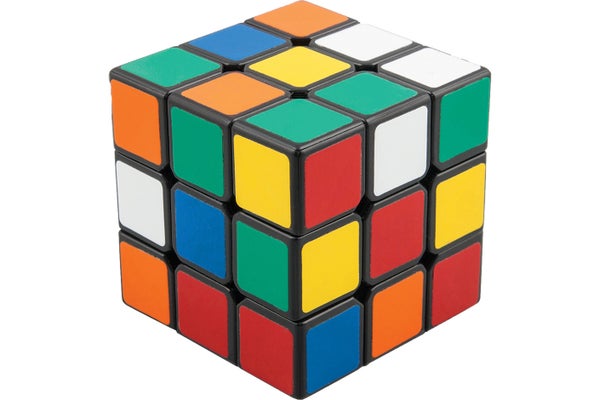Cracking the Cube: Going Slow to Go Fast and Other Unexpected Turns in the World of Competitive Rubik’s Cube Solving
by Ian Scheffler
Touchstone, 2016 ($26)
To those who know how, the Rubik's cube can be solved easily in less than 20 seconds. For the rest of us, unscrambling the puzzle at all is next to impossible. Writer Scheffler, who achieved his first “sub-20” time in 2015, takes us inside the world of competitive cubing. He interviews legends such as Jessica Fridrich, who deduced some of the first algorithms for solving the puzzle speedily based on the mathematics of group theory. Fridrich, who was then a teenager in Czechoslovakia, used her solutions to win the nation's Rubik's cube championship in 1982, and the algorithms still dominate competitions today. Scheffler also travels to Budapest to meet the reclusive Erno Rubik, the Hungarian sculptor and architect who designed the cube in 1974. The inventor, a puzzle fanatic then and now, initially could not figure out how to solve his own creation, and he marvels with the author more than 40 years later about the life that the Rubik's cube has taken on in modern years. —C.M.
Voracious Science and Vulnerable Animals: A Primate Scientist’s Ethical Journey
by John P. Gluck.
University of Chicago Press, 2016 ($27.50)
On supporting science journalism
If you're enjoying this article, consider supporting our award-winning journalism by subscribing. By purchasing a subscription you are helping to ensure the future of impactful stories about the discoveries and ideas shaping our world today.
In 2015, after a lengthy debate on the ethics of animal research, the U.S. National Institutes of Health announced it would stop using chimpanzees for medical studies and retire its remaining 50 chimps. Gluck, who formerly led his own primate research laboratory, tells the heart-rending personal story of how he became an activist for animal rights. He explains what he calls the “emotional and ethical retraining” that he and other researchers typically undergo as they come up in the field, learning to put aside sympathy for animals in pain. But Gluck soon began to question whether the benefits of animal research truly justify the traumatic cost to its subjects, especially because such studies often fail to translate to human biomedical benefits. He argues that science and ethics cannot be separated and makes the case that a study that would be unethical to conduct on humans is probably unethical to conduct on animals as well.
—K.S.
The Spy Who Couldn’t Spell: A Dyslexic Traitor, an Unbreakable Code, and the FBI’s Hunt for America’s Stolen Secrets
by Yudhijit Bhattacharjee.
New American Library, 2016 ($27)
One day in 1999, sitting behind his desk at the National Reconnaissance Office, intelligence agent Brian Regan decided to betray his country. In this true-to-life thriller, writer Bhattacharjee recounts the scheme that Regan concocted to sell thousands of classified U.S. documents about Libyan missile sites, Iraqi air defenses, U.S. spying operations and other secrets. He reached out to potential buyers in coded letters that seemingly contained gibberish. Bhattacharjee examines how FBI agents deciphered these letters and followed clues to Regan’s secret identity, such as his military background, which gave him easy access to sensitive reports, his dire need for money and, most important, his poor spelling ability, which finally gave his ciphers away. Bhattacharjee lucidly explains the encryption techniques Regan used to hide information and the mathematics and cryptanalysis that eventually helped FBI agents break the codes. —K.S.
The Unnatural World: The Race to Remake Civilization in Earth’s Newest Age
by David Biello.
Scribner, 2016 ($26)
Planet Earth’s 4.5-billion-year history is divided into many geologic epochs, but the latest is unique. The “Anthropocene”—not an official epoch yet but one that many scientists are lobbying for—is named after us (anthropos being Greek for “human”) because in recent times, we have been the dominant force on the planet. Our cities, farms and factories have redrawn the landscape and crowded out other species, and the carbon dioxide we spew into the atmosphere has changed the global climate, modified the ocean chemistry and transformed Earth in innumerable ways. Journalist Biello, a contributing editor for Scientific American, makes an impassioned case for the proposed epoch and describes both what we have done to alter our planet and what we should do in the future to ensure its habitability for people as well as for the many other species that call it home. “The choices made this century,” Biello writes, “will help set the course of the entire planet for at least tens of thousands of years.” —C.M.


